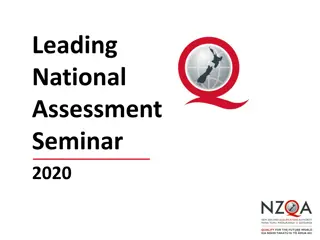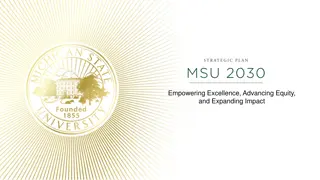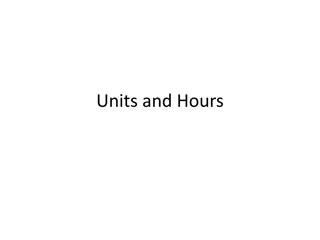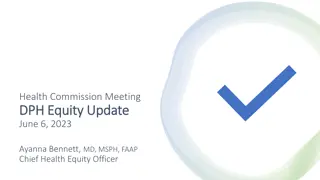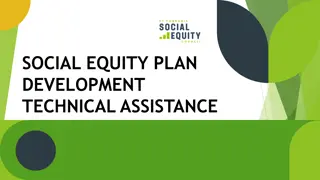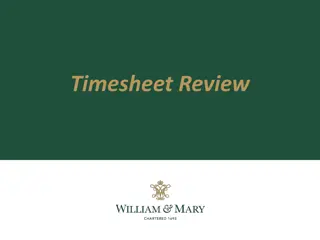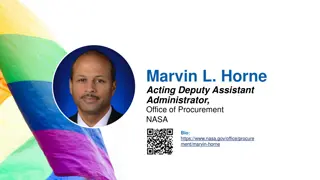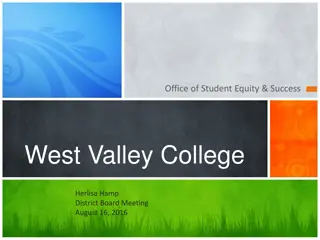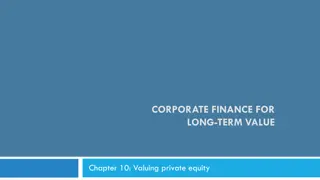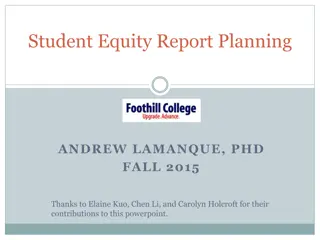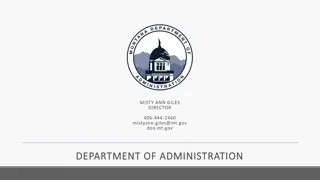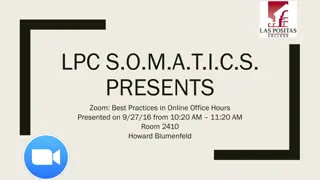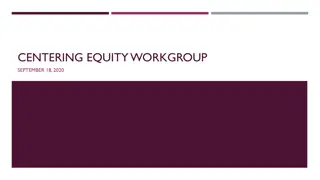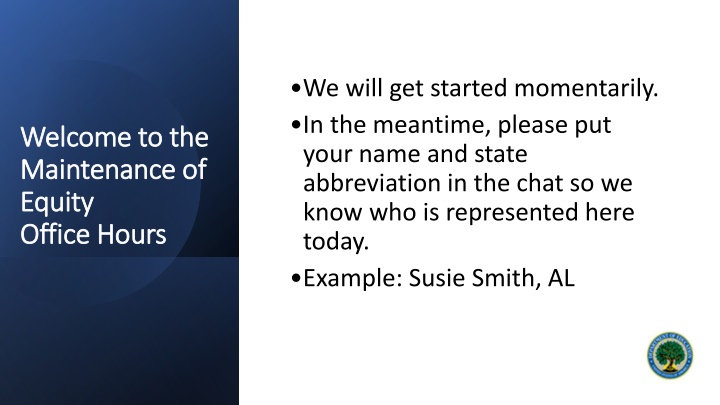
Maintenance of Equity (MOEquity) Requirements
Learn about the Maintenance of Equity (MOEquity) requirements established under the American Rescue Plan Act to protect schools serving students from low-income backgrounds from funding reductions. Stay informed about key timelines and recent developments in MOEquity guidance.
Download Presentation

Please find below an Image/Link to download the presentation.
The content on the website is provided AS IS for your information and personal use only. It may not be sold, licensed, or shared on other websites without obtaining consent from the author. If you encounter any issues during the download, it is possible that the publisher has removed the file from their server.
You are allowed to download the files provided on this website for personal or commercial use, subject to the condition that they are used lawfully. All files are the property of their respective owners.
The content on the website is provided AS IS for your information and personal use only. It may not be sold, licensed, or shared on other websites without obtaining consent from the author.
E N D
Presentation Transcript
We will get started momentarily. In the meantime, please put your name and state abbreviation in the chat so we know who is represented here today. Example: Susie Smith, AL Welcome to the Welcome to the Maintenance of Maintenance of Equity Equity Office Hours Office Hours
American Rescue Plan Elementary and Secondary School Emergency Relief (ESSER) Fund Maintenance of Equity (MOEquity) OFFICE HOURS August 12, 2021
Introductions Introductions Ian Rosenblum Deputy Assistant Secretary for Policy and Programs Delegated Authority to Perform the Functions and Duties of the Assistant Secretary Office of Elementary and Secondary Education Abel McDaniels Special Assistant Office of Elementary and Secondary Education Sarah Laven Jones Office of State & Grantee Relations Office of Elementary and Secondary Education
MOEquity Updates Dear Colleague Letter Updated FAQ Guidance Presenter: Ian Rosenblum Agenda Agenda Frequently Asked Questions Presenters: Abel McDaniels & Sarah Laven Jones
MOEquity MOEquity Timeline Timeline March 11, 2021: American Rescue Plan Act of 2021 (ARP Act) enacted June 9, 2021: MOEquity guidance for SEAs and LEAs released July 30, 2021: Baseline and initial MOEquity data submission deadline. Data submissions are posted here on the Department's website and will be updated as they are received. August 6, 2021: Updated MOEquity guidance and Dear Colleague Letter released October 15, 2021: MOEquity data submission deadline for SEAs that requested an extension
Maintenance of Equity Overview Maintenance of Equity Overview Maintenance of Equity (MOEquity) requirements were enacted for the first time in the American Rescue Plan (ARP) Act. These requirements safeguard school districts and schools that serve a large share of students from low-income backgrounds against experiencing a disproportionate reduction in funding in fiscal years (FYs) 2022 and 2023 (i.e., school years 2021-2022 and 2022-2023). These requirements also ensure that school districts serving the largest shares of students from low-income backgrounds do not receive a decrease in State funding below their FY 2019 level.
Recent Developments Recent Developments Dear Colleague Letter (DCL): On August 6, the Department issued a DCL that announced additional supports to assist with the successful implementation of the critical MOEquity requirements in the ARP Act and to continue to promote transparency at the SEA and LEA levels: Seeking additional input from the field Addressing specific implementation challenges for FY 2022 Updated Frequently Asked Questions: On August 6, the Department also issued updated MOEquity guidance to address additional questions from the field.
MOEquity MOEquity Dear Colleague Dear Colleague Letter Letter The Department is committed to supporting State educational agencies (SEAs) and local educational agencies (LEAs) in implementing the ARP Act s MOEquity provisions with fidelity to the law. We also recognize that, with any new law that touches on fiscal issues, there will naturally be questions and challenges applying a single set of requirements to the specific circumstances of each State s education finance system, and even more so during a pandemic which has led to greater uncertainty in enrollment levels and other factors.
Updated Updated MOEquity MOEquity FAQ Guidance FAQ Guidance In response to questions from SEAs and LEAs, the Department updated the June MOEquity guidance to provide greater clarity and additional advice and options regarding technical implementation consistent with the law during this challenging time. Specifically, the updated guidance will assist SEAs and LEAs in applying the statutory MOEquity provisions to their specific education finance systems in three areas. Updated Questions: 17, 18, 26, 32; New Questions 19(a) and 27(a); New Appendix B
Funding Sources Funding Sources Which funding sources must an SEA or LEA include when determining whether it maintained fiscal equity? Reimbursements: When determining whether it maintained fiscal equity for high-need LEAs and highest-poverty LEAs, an SEA generally includes funds appropriated and allocated by the State to all LEAs for current expenditures for free public education (i.e., funds provided through the primary funding mechanisms, categorical funding, and other State support). An SEA may determine that some current expenditures, however, are not appropriate for MOEquity determinations. For example, if, in addition to allocating funds under a State s primary funding formula, the State reimburses an LEA for specific expenses (e.g., costs of educating students with disabilities, costs of transportation, centralized costs of substitute teachers), such State funds may, by necessity, vary by LEA annually because they are based on actual costs of a service. Accordingly, a State may exclude such State funds from its MOEquity calculations by making an individualized, fact-based determination that including such funds would be inconsistent with ARP ESSER, while continuing to reimburse the LEA and avoiding an impact on the resources or services needed. (Updated FAQ 17)
Funding Sources Funding Sources Which funding sources must an SEA or LEA include when determining whether it maintained fiscal equity? (continued) Local Revenues as State Guarantee : State MOEquity considers the use of State funding sources only. Thus, generally, an SEA may not include Federal funds, local revenues, or support from private donors. In some instances, however, local revenues, such as property taxes or taxes on mineral rights, are part of a State s guarantee for education under State law. If the State includes such local revenues as part of its determination of State funding to meet a guaranteed funding level or as part of a equalization funding structure in order to ensure fiscal equity for LEAs, the State may consider the local revenues to be State funds for MOEquity purposes only and part of the calculation to determine any reduction of per-pupil funding. (Updated FAQ 17)
Funding Sources Funding Sources Which funding sources must an SEA or LEA include when determining whether it maintained fiscal equity? (continued) One-time Appropriations: An SEA or LEA must use consistent funding sources from year to year. As a result, if an SEA or LEA can document a one-time appropriation for a specific purpose (e.g., a revenue surplus that was distributed only for one year), then those funds may be excluded from MOEquity calculations. (Updated FAQs 17,26)
Enrollment Enrollment How may an SEA or LEA determine enrollment for purposes of calculating per-pupil funding levels? To determine the per-pupil amount for each fiscal year, an SEA or LEA may use the most appropriate available enrollment data for the applicable fiscal year, which could be the same enrollment data it relied on to distribute or allocate funds for the applicable fiscal year. These data may include, among other data, its prior year enrollment data, an average of multiple prior years enrollment, or projected enrollment data for the next fiscal year. (New FAQs 19(a), 27(a))
LEA Exceptions LEA Exceptions Are there LEAs excepted from the local Maintenance of Equity requirements for the 2021-2022 school year? An LEA is excepted from the MOEquity requirements if it enrolls fewer than 1,000 students, has only one school, has only one school per grade span, or demonstrates an exceptional or uncontrollable circumstance. For FY 2022 MOEquity determinations, the Department recognizes that LEAs may face certain one- time implementation challenges due to the enactment of the ARP Act in March 2021 when LEA budgeting was already underway in many places and the impact of the pandemic that has resulted in significant ongoing uncertainty about school-level enrollment for the 2021-2022 school year. Therefore, an LEA experiencing these circumstances may demonstrate that it is excepted from the MOEquity requirements for FY 2022 by certifying to the Department that it did not and will not implement an aggregate reduction in combined State and local per-pupil funding in FY 2022 (i.e., is not facing overall budget reductions). (Updated FAQ 32)
LEA Exceptions LEA Exceptions An LEA that certifies it will not implement an aggregate reduction in combined State and local per-pupil funding in FY 2022 in order to demonstrate an exceptional or uncontrollable circumstance must complete the Certification of Exception from Local MOEquity Requirements in Appendix B to the updated FAQs and submit the certification to its SEA. Each SEA should keep on file the Appendix B certifications submitted by LEAs. In the near future, the Department will notify SEAs on how to report this information about exceptions.
LEA Exceptions LEA Exceptions Otherwise, each claim of exception will require a case-by-case review by the Department. For example, an exceptional or uncontrollable circumstance might include an exceptional circumstance such as increased one-time expenditures in the baseline year (school year 2020-2021) due to the pandemic or a very small school where the MOEquity calculations do not result in meaningful information about resource availability, or an uncontrollable circumstance such as a significant change in the expenses of a school that no longer serves a student whose educational and support needs required services that have a particularly high cost. An LEA that can demonstrate an exceptional or uncontrollable circumstance should submit a request to its State mailbox [State.oese@ed.gov] and copy the appropriate SEA officials for awareness. (Updated FAQ 32)
MOEquity MOEquity and Maintenance of Effort and Maintenance of Effort Do State funding sources differ for MOEquity and MOE? They might. For example, an SEA may include funds for capital outlays and debt service to establish State support for elementary and secondary education when determining MOE under the Education Stabilization Fund programs. In contrast, in calculating MOEquity, an SEA generally must use funds appropriated and allocated by the State to all LEAs for current expenditures for free public education, excluding funds appropriated and allocated for capital outlays and debt service that may not accurately reflect an annual comparison among LEAs in the State. Similarly, in calculating MOEquity, an SEA may include local revenues, (e.g., property taxes or taxes on mineral rights), that are part of a State s guarantee for education under State law. Because the purpose of MOEquity is to ensure fiscal equity for high-need LEAs and highest- poverty LEAs, including local revenues required by State law as a guarantee or to equalize State funding for education is integral to understanding whether the State-determined funding level (including both State and local revenue components) is maintaining fiscal equity. An SEA, however, may not include local funds when quantifying State support for elementary and secondary education when determining MOE under the Education Stabilization Fund, which focuses only on funds that are appropriated or allocated by the State. (Updated FAQ 18)
Additional Additional MOEquity MOEquity FAQs FAQs
If an SEA uses the previous year's enrollment figures to determine State per-pupil funding amounts, how should it account for this in its MOEquity calculations? To determine the per-pupil amount for each fiscal year, an SEA may use the most appropriate available enrollment data for the applicable fiscal year, which could be the same enrollment data it relied on to appropriate or allocate State funds for the applicable fiscal year. These data may include, among other data, prior year enrollment data, projected enrollment data for the next fiscal year, an average of multiple prior years enrollment, or some other enrollment formula established by the State. (Question 19(a) Updated FAQs)
When calculating State per-pupil amounts, how should a State account for students who attend a State-run school (e.g., a State- run school for the deaf)? A State is not required to include funding and enrollment data for students who attend a State-run school when determining MOEquity if that school does not receive funding as an LEA under the State s primary funding mechanisms.
When calculating State per-pupil amounts, should a State include students enrolled in Pre-K programs? If a State includes Pre-K students for enrollment and funding in the State s primary funding formula for all LEAs, then a State should include the funding and enrollment data for pre-K in determining Maintenance of Equity. Otherwise, the State need not include Pre-K students.
If an LEA identified as high-need or highest-poverty is excepted from local MOEquity requirements, must it be included in State MOEquity calculations? MOEquity exceptions only apply to the local MOEquity requirements, not State MOEquity requirements. Accordingly, an SEA must include all LEAs in its State MOEquity calculations. (Question 32 Updated FAQs)
What constitutes a grade span for determining Maintenance of Equity? We believe a State is in the best position to define grade span and may have a definition within the State for other purposes, including for Title I ranking purposes or determining comparability. If a State does not have a definition, then an LEA may rely on the same definition that it uses for these Title I purposes.
What methods should an SEA use to determine enrollment (e.g., average daily membership, attendance, number of full-time-equivalent students)? To determine enrollment, an SEA may use the most appropriate, available data for the applicable fiscal year, which could be the same enrollment data it relies on to appropriate or allocate State funds for the applicable fiscal year. These data may include, among other data, prior year enrollment data, projected enrollment data for the next fiscal year, an average of multiple prior years enrollment, or some other enrollment formula established by the State. (Question 19(a) Updated FAQs)
Must an LEA be consistent in determining MOEquity on a districtwide basis or by grade span for both fiscal and staffing equity in both fiscal years 2022 and 2023? Each LEA may determine whether to analyze MOEquity by grade span or districtwide. An LEA may alternate between conducting its MOEquity analyses on a districtwide or grade span basis from year to year. An LEA may also decide to use a different unit of analysis for its fiscal equity and staffing tests, if there are truly meaningful differences in how it allocates and distributes resources and staffing.
How should an LEA account for school openings or closures when analyzing MOEquity? An LEA should not identify a new school as one of its high-poverty or high- need schools because it would have no data with which to complete the MOEquity analysis. An LEA should also exclude schools that are closed from its MOEquity analysis.
Does an exception to the local Maintenance of Equity requirements apply to both the fiscal and staffing analysis? Yes. If an LEA is excepted from local Maintenance of Equity, the LEA is not required to maintain either fiscal or staffing equity for that year.
If a student with disabilities requires 1-1 staffing, and the student leaves a protected school, is the LEA required to maintain the increased staffing level for that school? An LEA may seek an exception for "exceptional or uncontrollable circumstances." As described in Question 32, an uncontrollable circumstance could include a significant change in the expenses of a school that no longer serves a student whose educational and support needs required services that have a particularly high cost.
What staff should LEAs account for when defining the staffing ratio requirement? Should an LEA include school site administrators or contracted staff, as well as teachers, when determining staffing equity? Each LEA must include all paid staff, both instructional and non- instructional, when determining whether it maintained staffing equity on an FTE basis. This would include all employees and those hired by contract who perform school-level services. An LEA includes staff who split their time between more than one school building in the LEA. For example, if a districtwide literacy coach supports teachers in two different schools, the LEA must include the proportional FTE for each school. (Question 28 Updated FAQs)
If an SEA cannot submit all of the required baseline and initial data listed in Appendix A by July 30, should they still submit partial data? Yes. States should have been able to submit responses to 1, 6, and 9 from Appendix A by July 30 and should have communicated through their State mailbox if there is a reason they could not or cannot do so.
Will SEAs that have requested an extension have the opportunity to revise or resubmit data after July 31, 2021 or October 15, 2021? Yes. All States that have submitted MOEquity data have the ability to revise or resubmit updated data as it becomes available to them.
Can States use an alternative methodology to identify high-need and high- poverty LEAs? A State may not use an alternative methodology to identify its high-need and high-poverty LEAs for the purposes of maintaining equity. Section 2004(d)(2) and (3) requires the State to use the most recent satisfactory data from the Department of Commerce. See Questions 10-12.
Thank you for attending Maintenance of Maintenance of Equity Equity Office Hours Office Hours If you have additional questions related to MOEquity, please submit them to your State mailbox [State.oese@ed.gov]

